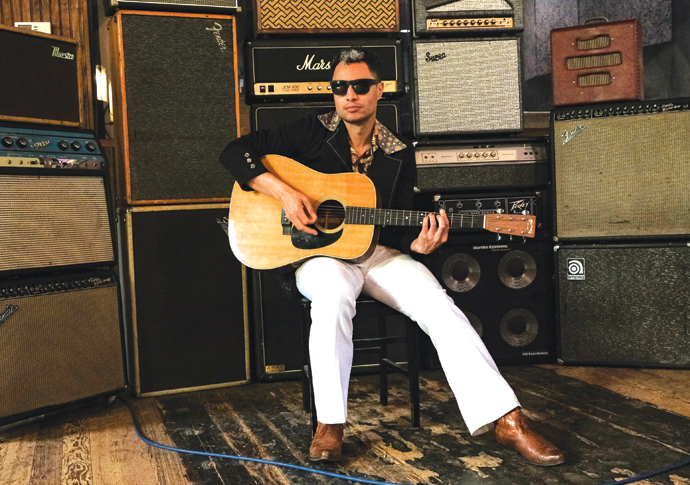The shape-shifter
Tackling hip-hop, jazz, R&B and soul, José James is a very genre-fluid individual, writes Rob Ryan
Thursday, 16th May 2024 — By Rob Ryan

José James [Janet Beckman]
JOSÉ James is a highly protean jazz performer. Or perhaps that should be kaleidoscopic, constantly moving to shine a light on different aspects of his talent and his latest enthusiasms.
Over the course of 12 albums he has tackled hip-hop, jazz, R&B, soul, the Bill Withers songbook, Billie Holiday, Christmas – he is a very genre-fluid individual. It might sound like a very disparate catalogue, but live it coalesces nicely– James has the ability and stagecraft to blend his influences into a coherent whole.
For his 13th album, 1978 (Rainbow Blonde Records) he has gone back to the year of his birth and the music of that era. Think Prince, Marvin, Gaye, Stevie Wonder, a sprinkling of the d’Angelo albums of the 90s, yet he has kept that laidback jazzy seam that runs through all of his recordings.
As with those singers he has also inserted political statements – James was born in Minneapolis and grew up not far from where George Floyd was murdered. Hence the song 38th & Chicago, named after the intersection where the notorious interaction between Floyd and the police took. Just like Marvin Gaye, though, the message is gift wrapped in silky vocals and slinky rhythms and underpinned with solid grooves.
James has a particular affection for London – he was living here when Gilles Peterson signed him to his Brownswood label for The Dreamer (2008). He has also recorded for Blue Note, Impulse! and Rainbow Blonde, the label he runs with his wife, singer, songwriter and producer Talia Billig (aka Taali).
José James brings the new album to Ronnie Scott’s in Soho for four shows on May 31 and June 1. www.ronniescotts.co.uk/
I caught up with him for a Q&A beforehand…
ROB RYAN: You lived in London for a while. Where in the city were you based?
JOSE JAMES: I was in Shoreditch, near Hoxton Square. It was the last gasp of that neighbourhood being affordable and cool, and I really loved it.
RR: What do you remember most of that time? Where did you hang out?
JJ: Plastic People was the spot. There were so many great nights there, it was honestly mind-blowing. I spent a lot of time and money in Rough Trade as well, learning about new music. And I would hang out with my friend Hassan Hajjaj at his shop near Arnold Circus.
RR: When you were growing up in Minneapolis how did you consume music? Was it through the radio, records, CDs? Do you remember the first gigs you attended?
JJ: Radio was KBEM for Jazz and KMOJ for hip-hop and R&B. The Electric Fetus is the best record store in Minneapolis and was Prince’s favourite. I worked in a café and spent all my money on CDs. It was great. The first gig I saw was Michael Jackson’s Bad tour. It has all been downhill since then.
RR: Obviously, the last track on the record 38th & Chicago has a sombre and shocking connection to where you grew up. At one time jazz had a very powerful political stance – Members Don’t Git Weary, Freedom Now! etc. Do you think that has been lost or does engagement with politics and social issues take a different form now?
JJ: I think that Max Roach, Abbey Lincoln and Charles Mingus were political, but I don’t think jazz was overtly political in general. The 60s were a heady time and I think there was an expectation to speak out on the times. My generation and the coming generations, I think we’re disillusioned with politics. There are plenty of social issues that get discussed in rap and hip-hop, and there are artists like Chief Xian in jazz engaging with this.
RR: What can listeners expect from the rest of the 1978 album?
JJ: Party and politics. The first half of the album is romantic, sensual, seductive party music. The second half is a global view of Blackness, featuring collaborations with Baloji and Latin Grammy winner Xenia França. There are also tributes to George Floyd and Trayvon Martin. This might be my best album yet.
RR: You have a substantial “book” to choose from when putting together sets. Do you tailor the show to the venue – for instance, would you do the same set for Earth [in Dalston] and you would at Ronnie’s?
JJ: No, I don’t play to the venue, I present the new project. The only difference is that jazz clubs typically do two sets vs one long 90-minute plus concert, which I prefer. For my music a longer concert tells a more complete story.
RR: Does any Bill Withers still feature in the set? Can you share a memory of Bill?
JJ: I’m honoured to perform his catalogue and I often include songs from Bill. Lovely Day, Just The Two of Us, these are classics. When I met Bill Withers it was clear within three seconds that he was a genius. We’re just lucky that he applied that genius to music and gave us his enduring songs.
RR: Difficult question – could you suggest three records for our readers that encapsulate the best of vocal jazz for you?
JJ: John Coltrane and Johnny Hartman, Billie Holiday – Music For Torching, Ella Fitzgerald and Louis Armstrong – Ella and Louis.
• At around the same time that James is taking a dive into the past, Kamaal Williams (aka Henry Wu and once half of the pioneering but sadly shortlived Yussef Kamaal) is demonstrating how jazz can assimilate hip-hop, broken beat and house to move it into the future. He is playing for three nights at Camden’s Jazz Café (May 29-31) with different friends and collaborators on each gig. Details: https://thejazzcafelondon.com/whats-on/
A must-see for anyone who likes their jazz clubby, dubby and funky.